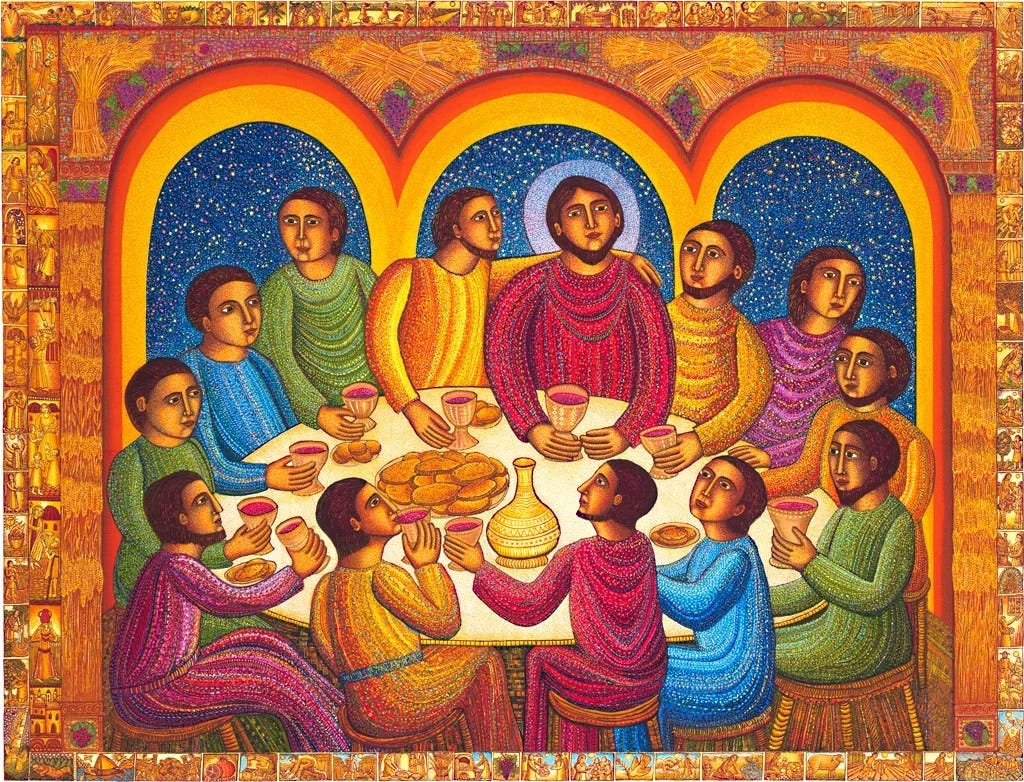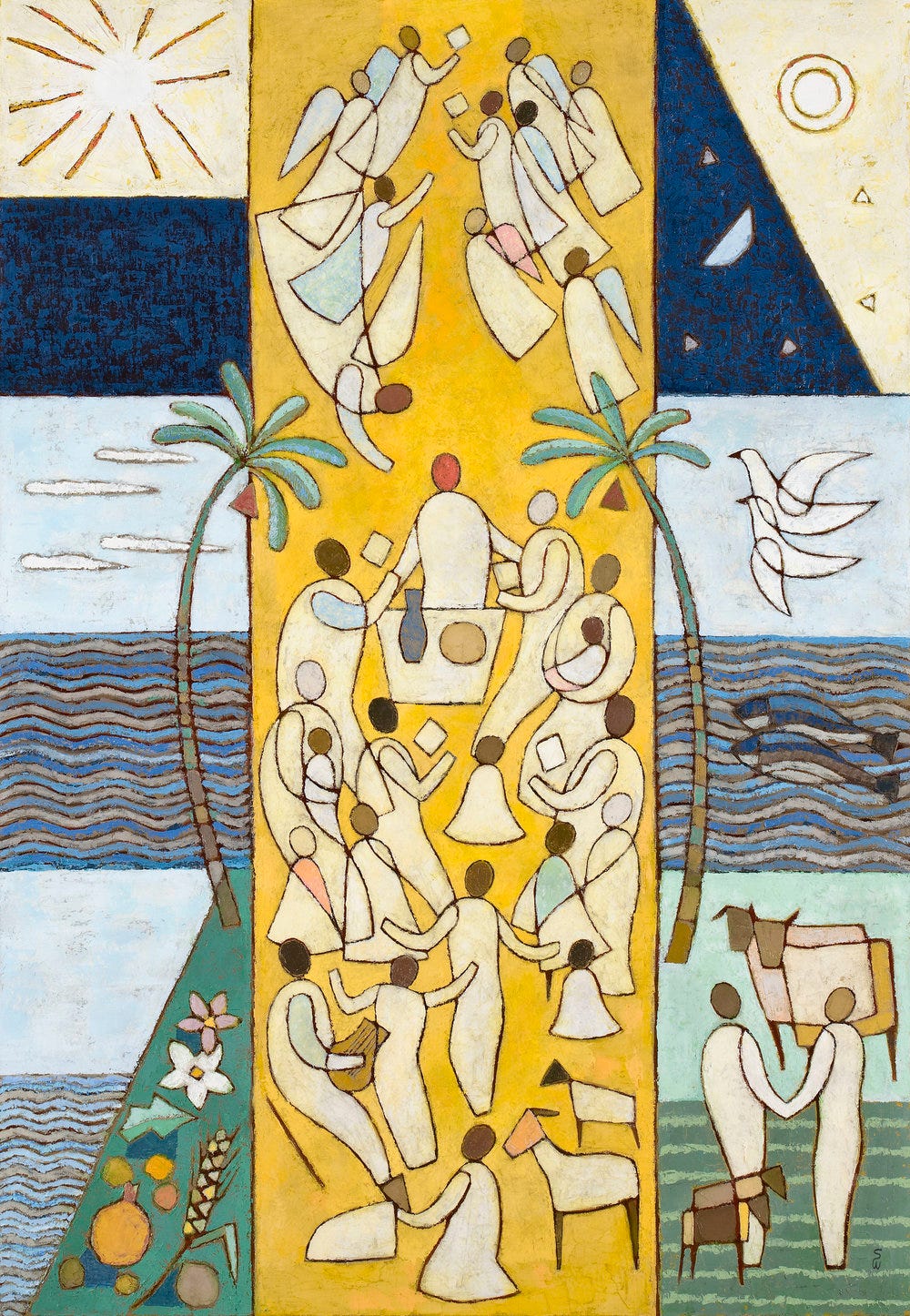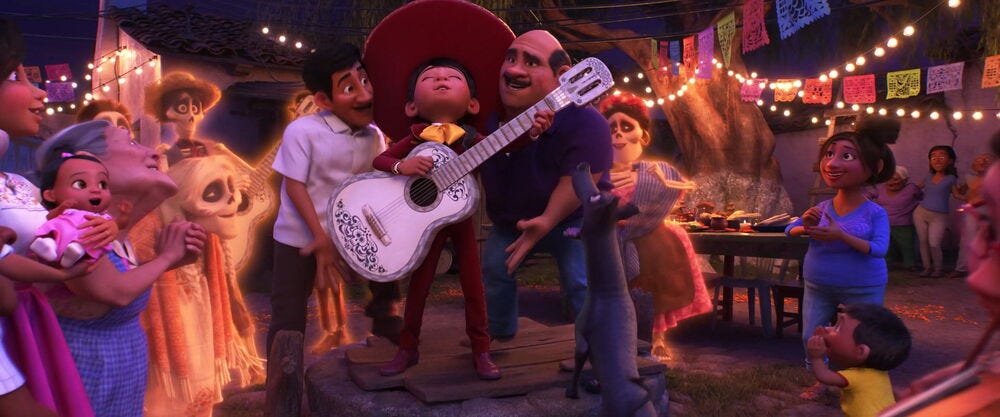In Harry Potter and the Order of the Phoenix, at the book’s end, Harry loses his beloved Godfather, Sirius Black, when he is cursed and pushed into and through “the veil,” a thin space that acts as a mystical barrier between the realm of the living and the realm of death. The scenes that follow detail Harry fervently and anxiously scrambling around Hogwarts Castle, seeking a means to encounter and even commune with his Godfather again. He seeks the magic and wisdom of a two-way mirror and school ghost, and comes away from both with a poignant awareness of the great chasm that now separates him from his Godfather. An important exchange happens just after these events between Harry and his friend, Luna Lovegood:
“Anyway...why aren't you at the feast?" Harry shrugged. “Just didn't feel like it.” “No,” said Luna, observing him with those oddly misty, protuberant eyes. “I don't suppose you do. That man the Death Eaters killed was your godfather, wasn't he? Ginny told me.” Harry nodded curtly, but found that for some reason he did not mind Luna talking about Sirius. He had just remembered that she too could see thestrals. “Have you...” he began. “I mean, who...has anyone you've ever known died?” “Yes,” said Luna simply, “my mother. She was quite an extraordinary witch, you know, but she did like to experiment and one of her spells went rather badly wrong one day. I was nine.” “I'm sorry,” Harry mumbled. "Yes, it was rather horrible," said Luna conversationally. “I still feel very sad about it sometimes. But I've still got Dad. And anyway, it's not as though I'll never see Mum again, is it?” “Er -- isn't it?” said Harry uncertainly. She shook her head in disbelief. “Oh, come on. You heard them, just behind the veil, didn't you?””1
The Veil in Harry Potter is a doorway, where the distance between the realms of life and death is almost imperceptible, close enough to hear the faint whispers of those standing on the other side of this unique barrier. Though close, the space between the two is impenetrable, for to inhabit one space is to forfeit inhabiting the other. For those that have lost a loved one, this is the pain of living—so close, yet so far. All who have felt this pain long for one who can bring together the great chasm between these realms.
Isaiah 25 prophetically speaks of an eschatological feast consisting of two components: humankind on a mountain swallowing up God’s holy food, and God on a mountain swallowing up the death that enshrouds humankind. This is caviar and manure, fine wine and bleach, sourdough bread and pig slop—this is life and death. Surely, this peculiar pairing is apparent in the life-giving Eucharistic event, for when Christians partake in the elements they “proclaim the Lord’s death until he comes.”2 At the altar, Christians pull up a seat to a family meal, participating in a timeless banquet stretching from Calvary to the marriage supper of the Lamb, for “liturgy is always in the present tense.”3 The nature of this eschatological meal is hinted at in Matthew’s Gospel, for when Jesus dies, a mighty earthquake cracks open stone graves, and when He raises, many holy people are raised with him.4 Thus, it should be no surprise that early Christians celebrated the Eucharist at tombs, for to them, “the communion of saints was a living presence in every celebration of the eucharist.”5 Just as Jesus Christ is the new temple, who brings together Heaven And Earth in himself, in his death, he becomes a holy thin space between the realms of death and life. In Jesus Christ, death is made into a doorway, an opened veil between the land of the living and the land of the dead, and His Holy Meal, which is Himself, is a burial balm unto eternity.
In 2014, prolific director, Steve McQueen, spoke with Kirsty Young when appearing on the radio program broadcast, Desert Island Discs. Here, when speaking about two of his award winning historical dramas, Hunger and 12 Years a Slave, he described the experience as feeling like the cast and crew were, “dancing with ghosts,” which Young further defines as a kind of “visceral magic.”6 Though McQueen is using this to describe the poignant immediacy of the past when capturing true stories in the present, his imaginative expression is helpful when paired with the imagination of C.S. Lewis. In his posthumously published, Letters to Malcolm: Chiefly on Prayer, Lewis famously talks about liturgy as dance, but he neglects to mention who Christians are dancing with.7 When Christians encounter the Eucharistic Table, they encounter Jesus Christ, who is the thin space between the realm of the living and the realm of the dead, the one who describes Himself as, “the Living One; I was dead, and now look, I am alive for ever and ever! And I hold the keys of death and Hades.”8 Maybe this is why the author of Hebrews is able to so confidently assert that Christians are “surrounded by so great a cloud of witnesses.”9 The Book of Common Prayer helpfully reminds worshippers of this reality by prefacing the Sanctus in the Eucharistic Prayer, with “therefore, we praise you, joining our voices with Angels and Archangels and with all the company of heaven.”10 Just as David leaped and danced as the Ark of the Covenant entered the City of David, so do Christians of all ages as the presence of the Lord is offered anew in the Eucharistic event, for without a doubt Christians are dancing with ghosts.
A final image that captures this mysterious Eucharistic reality of the living feasting on the Bread of Heaven in the company of the saints from every age is depicted in Pixar’s 2017 animated film, Coco. This film follows the events of a boy named Miguel, who crosses between the realms of life and death on the Day of the Dead, inadvertently knitting back together his family through an adventure worth watching. Traditionally, home altars are made for loved ones that have died during Day of the Dead festivities, and in Coco, only the people who are remembered are able to cross the bridge from the realm of the dead to the realm of the living. The movie ends one year after Miguel’s journey with a complete home altar made for his loved ones, including ones long forgotten, and the result is a party: feasting ensues, ghosts dance among the living, and the realms of life and death are fused together, if only for a moment.
This is the reality of the Eucharist. We partake in the meal that transcends finite time and place as we are caught up in the eternal company of heaven. The empty tomb of Jesus Christ has become an altar, the very source of a family banquet that will never end—angels and archangels rejoicing, brothers and sister laughing, grandparents and godparents dancing, and forgotten saints only remembered by their faithful Brother, Jesus Christ, singing forever and ever.
J. K. Rowling, Harry Potter and the Order of the Phoenix, (New York: Scholastic Press, 2003), 863.
1 Corinthians 11:26: NRSV
Robert Louis Wilken, The Spirit of Early Christian Thought: Seeking the Face of God, (New Haven, CT: Yale University Press, 2005), 35.
Matthew 27:51-53
Robert Louis Wilken, The Spirit of Early Christian Thought, 46.
Kirsty Young (Host). September 21, 2014. Desert Island Discs: Steve McQueen. BBC Radio 4. https://www.bbc.co.uk/sounds/play/b04hml41
C. S. Lewis. Letters to Malcolm: Chiefly on Prayer, Harvest Books, 1973, 4.
Revelation 1:18
Hebrews 12:1
The Book of Common Prayer, Anglican Liturgy Press, 2019, 115.







